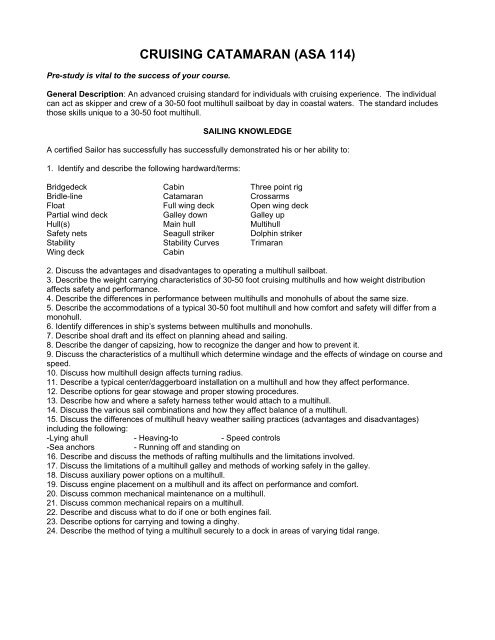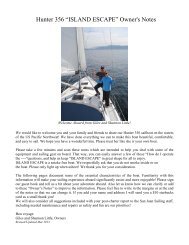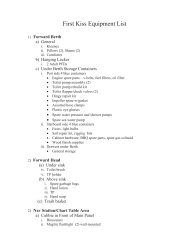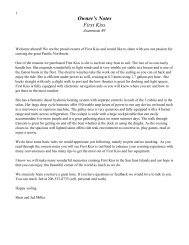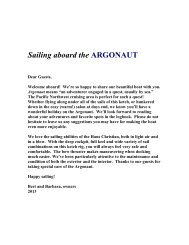CRUISING CATAMARAN (ASA 114) - San Juan Sailing
CRUISING CATAMARAN (ASA 114) - San Juan Sailing
CRUISING CATAMARAN (ASA 114) - San Juan Sailing
Create successful ePaper yourself
Turn your PDF publications into a flip-book with our unique Google optimized e-Paper software.
<strong>CRUISING</strong> <strong>CATAMARAN</strong> (<strong>ASA</strong> <strong>114</strong>)<br />
Pre-study is vital to the success of your course.<br />
General Description: An advanced cruising standard for individuals with cruising experience. The individual<br />
can act as skipper and crew of a 30-50 foot multihull sailboat by day in coastal waters. The standard includes<br />
those skills unique to a 30-50 foot multihull.<br />
SAILING KNOWLEDGE<br />
A certified Sailor has successfully has successfully demonstrated his or her ability to:<br />
1. Identify and describe the following hardward/terms:<br />
Bridgedeck Cabin Three point rig<br />
Bridle-line Catamaran Crossarms<br />
Float Full wing deck Open wing deck<br />
Partial wind deck Galley down Galley up<br />
Hull(s) Main hull Multihull<br />
Safety nets Seagull striker Dolphin striker<br />
Stability Stability Curves Trimaran<br />
Wing deck<br />
Cabin<br />
2. Discuss the advantages and disadvantages to operating a multihull sailboat.<br />
3. Describe the weight carrying characteristics of 30-50 foot cruising multihulls and how weight distribution<br />
affects safety and performance.<br />
4. Describe the differences in performance between multihulls and monohulls of about the same size.<br />
5. Describe the accommodations of a typical 30-50 foot multihull and how comfort and safety will differ from a<br />
monohull.<br />
6. Identify differences in ship’s systems between multihulls and monohulls.<br />
7. Describe shoal draft and its effect on planning ahead and sailing.<br />
8. Describe the danger of capsizing, how to recognize the danger and how to prevent it.<br />
9. Discuss the characteristics of a multihull which determine windage and the effects of windage on course and<br />
speed.<br />
10. Discuss how multihull design affects turning radius.<br />
11. Describe a typical center/daggerboard installation on a multihull and how they affect performance.<br />
12. Describe options for gear stowage and proper stowing procedures.<br />
13. Describe how and where a safety harness tether would attach to a multihull.<br />
14. Discuss the various sail combinations and how they affect balance of a multihull.<br />
15. Discuss the differences of multihull heavy weather sailing practices (advantages and disadvantages)<br />
including the following:<br />
-Lying ahull - Heaving-to - Speed controls<br />
-Sea anchors - Running off and standing on<br />
16. Describe and discuss the methods of rafting multihulls and the limitations involved.<br />
17. Discuss the limitations of a multihull galley and methods of working safely in the galley.<br />
18. Discuss auxiliary power options on a multihull.<br />
19. Discuss engine placement on a multihull and its affect on performance and comfort.<br />
20. Discuss common mechanical maintenance on a multihull.<br />
21. Discuss common mechanical repairs on a multihull.<br />
22. Describe and discuss what to do if one or both engines fail.<br />
23. Describe options for carrying and towing a dinghy.<br />
24. Describe the method of tying a multihull securely to a dock in areas of varying tidal range.
SAILING SKILLS<br />
A certified Sailor has successfully demonstrated her or his ability to:<br />
Boat Handling Under Power<br />
25. Cast off and safely leave a dock with at least two different wind directions relative to the bow (i.e. wind<br />
across the stern and wind across the beam).<br />
26. Stop the bow of the boat within four feet of a marker while maneuvering under power. Perform the exercise<br />
upwind, downwind, and with the wind across the beam.<br />
27. Maneuver the boat under power in a confined space, noting effects of wind and current.<br />
28. Maneuver the boat within 2 feet of, and parallel to a dock. Define and carry out a bail-out plan.<br />
29. Turn the boat in the tightest possible circle to determine its turning radius. Twin screw boat s will perform<br />
the exercise with screws turning in opposite directions and again with screws turning in the same directions.<br />
30. Repeat item 29 turning the boat in the opposite direction and compare the differences between both turns.<br />
31. Repeat items 29 and 30 while making stern way (going backwards).<br />
32. Steer a straight course of at least 10 boat lengths in reverse using moderate speed.<br />
33. If the boat used for certification is equipped with two engines, repeat items 30-31 using one engine then the<br />
other.<br />
34. Steer multihull using an emergency steering device.<br />
• Moving forward on a steady bearing<br />
• Moving backward on a steady bearing<br />
• Moving forward on a figure 8 course<br />
Person Overboard<br />
35. Demonstrate a skipper’s actions and commands while under power from the time a member of a crew falls<br />
overboard without warning until the crew is safely recovered.<br />
36. Describe at least two methods of getting a person out of the water and back on board a multihull.<br />
Boat Handling Under Sail<br />
Points of Sail<br />
37. Function as helmsman and crew giving correct commands and proper responses while demonstrating the<br />
proper techniques of closed hauled sailing, reaching (all three points), running, tacking and jibing, heading up,<br />
bearing way and luffing while noting the differences and likenesses of sailing a multihull vs. monohull.<br />
38. Sail an ordered compass course for 5 minutes without varying more than 10 degrees from the heading.<br />
39. Sail a figure 8 course between two buoys noting acceleration/deceleration times and momentum during<br />
turns.<br />
40. While sailing at full power, luff sails and observe how long it takes for a multihull to come to rest.<br />
41. Trim luffing sails noting how long it takes to accelerate to full power.<br />
Person Overboard<br />
42. Demonstrate a skipper’s actions and commands while under sail from the time a member of the crew falls<br />
overboard without warning until the crew is safely recovered.<br />
• Use two different return techniques including the quick-stop method.<br />
Heavy Weather<br />
Reefing/heaving-to<br />
43. Reduce sail by reefing and shake out a reef while keeping the vessel under control and on course.<br />
44. Heave-to and get underway again, noting the vessel’s motion at different angles to the wind.<br />
45. Sail with mainsail only, then headsail only noting performance characteristics and limitations.<br />
Anchoring<br />
46. Use proper anchoring techniques to anchor using the following methods:<br />
• Two anchors off the bow or stern (Bahamian style)<br />
• Single bow anchor and bridle<br />
• Single bow anchor and stern to the beach (Med style)<br />
• Bow to a permanent mooring with bridle (if available)


